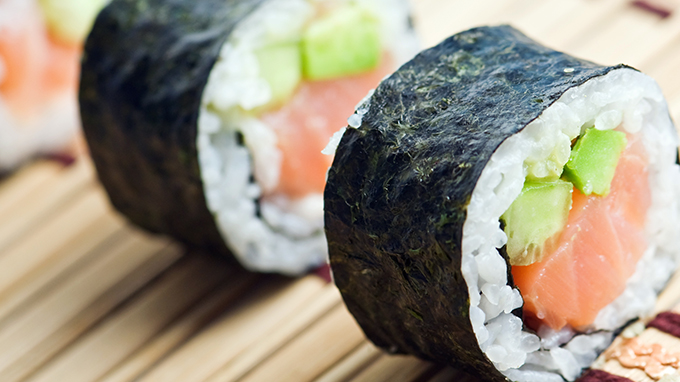What are the nutritional value of sushi
Sushi is a traditional Japanese national diet. Although I have a more complex and disgusted national sentiment towards this country, there is indeed a place for us to think about and learn from.

The practice of sushi is relative to aura Hong''s Chinese food can be said to be extremely simple, and there is no comparison at all. But why is sushi popular in the world? This has the advantages of simple operation, fresh ingredients, balanced nutrition and attractive color.
① The sushi method is not like the high-tech food of Man Han Quan Xi, Quan Jude and other cuisines. It is necessary to be a master to be able to be a high disciple. However, after you have seen it twice, you probably have an understanding of making. Anyone who can steam rice, can afford two or two live shrimps and half a small fish, and has a little hands and feet can imitate it.
②The selection of ingredients for sushi is also exquisite, but basically they are commonly used fresh ingredients, especially the seafood and meat used, and there is not too much complicated seasoning, you can eat the most natural Original taste; even the rice used for sushi is sweet, single-season rice produced in the north.
③ Japanese tableware is exquisite, the color combination of sushi is also very beautiful, and there is basically no artificially given color, mostly using the color of pure natural ingredients (except the pickled melon regulations), the color difference is relatively large , It is easy to leave a very deep impression. For example, grilled seaweed for sushi, wrapped in white, light and sour rice, wrapped in orange crab willow, lemon yellow melon sticks or green asparagus, neatly cut into a solid shape, Then up to a slice of fresh shrimp or salmon, tuna, crab, etc.
④The nutrition of sushi is relatively balanced. There is a small amount of meat food, but it will never exceed the rice as the main ingredient; there are also minerals and dietary fiber-rich algae, which can make up for the polished rice. It’s a pity; there are also vegetables, but it’s really a lack of proportion. These collocations are what many of our friends who only eat hard dishes and eat staple food should really appreciate.
⑤ Of course, sushi is incomparable to the full seat of Manhan, and at most it is a match with our traditional Chinese diet-dumplings. Dumplings are originally delicacies with a very reasonable nutritional structure, and even foreigners take them home as holiday food. It contains carbohydrate flour, minerals and vitamins, dietary fiber-rich vegetables, and protein-rich eggs or meat. It is the same healthy diet as our buns in Chinese food. But now the dumplings have changed somewhat. Because our living conditions are better, the nutritionally balanced dumplings have also become "thin-skinned stuffing, a meat egg", and the flour as carbohydrates is also less and less, and the proportion of vegetables is getting lower and lower, This breaks the basic dietary balance and turns dumplings from staple food to a "vegetable" role.
⑥ The sushi seasoning is relatively simple. You can use a small amount of sushi vinegar and sugar, but there will be no greasy thick taste of too much oil and salt, so the calorie and sodium intake are relatively low. And because all the ingredients are not cooked at high temperature, the nutrient loss can be minimized. It''s just that people with poor stomach are not suitable for eating sushi often, not only because the rice is slightly hard, but also because the sushi variety of raw fish and raw meat is not suitable for digestion, and there is no loss of nutrition, but the absorption is not very good.
Related Articles

- Can I drink tea for pregnancy
- Pregnancy is the most important event in a woman’s life. How to get pregnant smoothly and how to conceive a healthy baby is a problem that every couple and every family are very concerned a
- 2020-08-03

- What are the nutritional characteristics of nuts
- Nuts are one of the small foods that people like very much nowadays. They are rich in nutrients, high in protein, oil, minerals, and vitamins. They have excellent effects on human growth an
- 2020-08-03

- Celery leaves
- It is a habit of many people to eat celery and not to eat leaves. I think the leaves are just scraps. In fact, it is just wrong here. Almost all vegetables with leaves have a common featur
- 2020-08-03

- Is a cookie a nutritious food
- Biscuit is the most common snack food, but if it is said that biscuit is not nutritious, it seems to have aggrieved it. Every food has nutrients, even instant noodles or biscuits.
- 2020-08-03

- How to make a quick nutritious breakfast
- People often say that eating like an emperor for breakfast, like an aristocrat for lunch, and like a beggar for dinner will be healthier. How can I prepare a nutritious breakfast in 15 min
- 2020-08-03

- Can gout drink alcohol?
- Patients with gout should drink more water than wine. Gout diet is stricter, and even exceeds the dietary contraindications of diabetes, hypertension and high blood fat. Strict dietary tabo
- 2020-08-03
